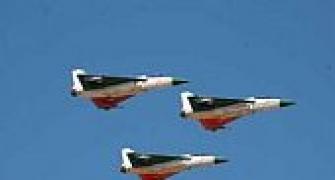Veteran fighter pilots lament the end of the dogfight, the evocative name for a twisty, sky-ripping, adrenaline-packed aerial duel, in which the winner gets behind his opponent and shoots him down with a burst of cannon fire.
Today, it is less about flying skill, cold nerve and highly-responsive aircraft; the modern-day dogfighting ace is an airborne video-game expert who uses radar to detect his foe at long ranges, and launch a beyond visual range (BVR) missile even before his victim realises that the engagement has begun.
Just days from now, a Sukhoi-30MKI fighter will take off from an Indian Air Force (IAF) base, an Astra missile fitted on its wing. This will be the first-ever flight of this indigenously developed BVR missile, which the IAF hopes will add punch to its fleet of Sukhoi-30MKI, Mig-29, Mirage-2000 and Tejas Light Combat Aircraft (LCA) fighters.
The Astra, built by the Defence R&D Laboratory, Hyderabad, will allow IAF pilots to hit enemy aircraft up to 44 km away, at altitudes up to 20,000 metres. Improving on that will be the Astra Mk II, with a longer range of 80 km.
The Astra incorporates many cutting-edge technologies. Here is how an Astra would take on an enemy fighter: an IAF fighter's radar picks up the target; the pilot launches an Astra missile. A high-energy propellant quickly boosts the missile to several times the speed of sound. At ranges beyond 15 km, the Astra cannot "'see' its target, so the IAF fighter guides the missile, relaying the target's continually changing position over a secure radio link. Once it is 15 km from the target, the Astra's onboard seeker picks up the target; after that the Astra homes in on its own.
At this point, the target would start turning and diving to throw off the missile. But the Astra manoeuvres better, and moves much faster, than even the most agile fighters. A radio proximity fuse measures the distance to the target. When the target is within 5 metres, the Astra's radio proximity fuse detonates its warhead, sending a volley of shrapnel ripping through the enemy fighter.
Most of these technologies have already been proven. The propulsion system, the data link between the aircraft and the Astra, the radio proximity fuse, the onboard computer, the inertial navigation system and other key technologies were developed at the DRDO's missile complex in Hyderabad.
The Astra's seeker is still imported from Russia, but the DRDO hopes to develop one.
The forthcoming test with a Sukhoi-30MKI is called a 'captive flight trial'; it will evaluate whether the Astra can withstand the physical stresses of supersonic flying and high-speed manoeuvring. Early in 2010, a 'captive-II flight trial' will check whether the Astra's avionics are properly matched with those of the Sukhoi-30MKI. The fighter should receive the missile's signals; and the Astra should receive the aircraft's commands.
"Matching an Indian missile with a Russian fighter's avionics has turned out to be a complex task", explains Mukesh Chand, one of the Astra's key developers, "But the Astra will be much better integrated with the Indian Tejas LCA."
Only in October 2010, after all the Astra's systems are certified airworthy, will a live Astra be fired from a fighter. But the project scientists are confident; in a September 2008 test in Balasore, Orissa, a ground-launched Astra shot down an electronic target, validating many of the most complex technologies.
A drawback in the Astra remains its high weight; even a heavy fighter like the Sukhoi-30MKI cannot carry the missile on its wingtip stations. In comparison with the Astra's estimated 150 kg, other BVR missiles like the Israeli Derby weigh around 100 kg only.
Nevertheless, the IAF believes the Astra will usefully supplement India's inventory of BVR missiles. The Russian R-77 Adder, which arms India's Russian aircraft fleet, faces worrying questions about its reliability. And the R530D missile, carried by the Mirage-2000, is nearing obsolescence.







